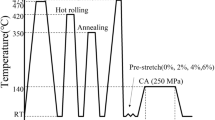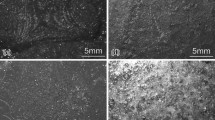Abstract
In this study, different pre-stretching and aging processes were applied to spray-formed Al-Cu-Li alloy 2195. The effects of different processes on the microstructures, mechanical properties, and corrosion behaviors of the alloy were examined. The strengthening and corrosion mechanisms were investigated. The samples treated with pre-stretching and aging have higher strength than the only aged samples. However, the strength is not significantly improved with the increase in the amount of pre-stretching. The pre-stretching treatment can suppress the formations of grain boundary precipitates (GBPs) and precipitate-free zones (PFZ), and the intergranular corrosion (IGC) sensitivity of the alloy is therefore reduced. The increase in pre-stretching promotes massive precipitation of the T1 phase, which leads to the negative shift of open-circuit potential. The over-aging treatment after pre-stretching leads to the growth of the PFZ and GBPs as well as the coarsening of the T1 phase. These changes in microstructure cause a decrease in mechanical properties and the re-sensitivity to the IGC. Under the same pre-stretching deformation, the two-step aging treatment (110 °C/12 h + 160 °C/24 h) can result in more intensive precipitation of the T1 phase, which enhanced the strength to a higher level. Meanwhile, the two-step aged alloy was immune to the IGC. The evolution mechanism of IGC for the alloy with different pre-stretching and aging processes was proposed based on the TEM characterization and the observation of IGC morphology.















Similar content being viewed by others
References
R.J. Rioja and J. Liu, The Evolution of Al-Li Base Products for Aerospace and Space Applications, Metall. Mater. Trans. A, 2012, 43(9), p 3325–3337
J.C. Williams and J.A. Starke, Progress in Structural Materials for Aerospace Systems, Acta Mater., 2003, 51(19), p 5775–5799
E.A. Starke, Jr, and J.T. Staley, Application of Modern Aluminum Alloys to Aircraft, Prog. Aerosp. Sci., 1996, 32(2-3), p 131–172
N.E. Prasad, A.A. Gokhale, and R.J.H. Wanhill, Aluminum-Lithium Alloys: Processing, Properties, and Applications, Butterworth-Heinemann, Oxford, 2013
T. Warner, Recently-Developed Aluminium Solutions for Aerospace Applications, Mater. Sci. Forum, 2006, 519, p 1271–1278
J.H. Kim, J.H. Jeun, H.J. Chun, Y.R. Lee, J.T. Yoo, J.H. Yoon, and H.S. Lee, Effect of Precipitates on Mechanical Properties of AA2195, J. Alloy. Compd., 2016, 669, p 187–198
W.A. Cassada, G.J. Shiflet, and E.A. Starke, The Effect of Plastic Deformation on Al2CuLi (T1) Precipitation, Metallurg. Trans. A, 1991, 22(2), p 299–306
B.M. Gable, A.W. Zhu, A.A. Csontos, and E.A. Starke, The Role of Plastic Deformation on the Competitive Microstructural Evolution and Mechanical Properties of a Novel Al-Li-Cu-X Alloy, J. Light Met., 2001, 1(1), p 1–14
Y.X. Wang, G.Q. Zhao, X. Xu, X.X. Chen, and W.D. Zhang, Microstructures and Mechanical Properties of Spray Deposited 2195 Al-Cu-Li Alloy through Thermo-mechanical Processing, Mater. Sci. Eng. A-Struct., 2018, 727, p 78–89
B.I. Rodgers and P.B. Prangnell, Quantification of the Influence of Increased Pre-stretching on Microstructure-Strength Relationships in the Al-Cu-Li Alloy AA2195, Acta Mater., 2016, 108, p 55–67
R.J. Rioja, E.L. Colvin, A.K. Vasudevan, and B.A. Cheney. Aluminum Alloy Two-Step Ageing Method and Article, U.S. Patent No. 4861391, 1989.
M. Romios, R. Tiraschi, C. Parrish, H.W. Babel, J.R. Ogren, and O.S. Es-Said, Design of Multistep Ageing Treatments of 2099 (C458) Al-Li Alloy, J. Mater. Eng. Perform., 2005, 14(5), p 641–646
P.S. Chen, A.K. Kuruvilla, T.W. Malone, and W.P. Stanton, The Effects of Artificial Ageing on the Microstructure and Fracture Toughness of Al-Cu-Li Alloy 2195, J. Mater. Eng. Perform., 1998, 7(5), p 682–690
P.S. Chen and W.P. Stanton, Artificial Effects on Cryogenic Fracture Toughness of the Main Structural Alloy for the Super Light-Weight Tank, MRS Online Proc. Libr. Arch., 1998, 551, p 285–290
T. Dorin, F. de Geuser, W. Lefebvre, C. Siglib, and A. Deschampset, Strengthening Mechanisms of T1 Precipitates and Their Influence on the Plasticity of an Al-Cu-Li Alloy, Mater. Sci. Eng. A Struct., 2014, 605, p 119–126
Y. Ma, X. Zhou, Y. Liao, Y. Yi, H. Wu, Z. Wang, and W. Huang, Localised Corrosion in AA2099-T83 Aluminium-Lithium Alloy: the Role of Grain Orientation, Corros. Sci., 2016, 107, p 41–48
Y. Lin, C. Lu, C. Wei, and Z. Zheng, Effect of Ageing Treatment on Microstructures, Tensile Properties and Intergranular Corrosion Behavior of Al-Cu-Li Alloy, Mater. Charact., 2018, 141, p 163–168
R.G. Buchheit, J.P. Moran, and G.E. Stoner, Electrochemical Behavior of the T1 (Al2CuLi) Intermetallic Compound and Its Role in Localized Corrosion of Al-2% Li-3% Cu Alloys, Corrosion, 1994, 50(2), p 120–130
J.L. Huang, J.F. Li, D.Y. Liu, R.F. Zhang, Y.L. Chen, X.H. Zhang, P.C. Ma, R.K. Gupta, and N. Birbilis, Correlation of Intergranular Corrosion Behaviour with Microstructure in Al-Cu-Li Alloy, Corros. Sci., 2018, 139, p 215–226
W. Yang, S. Ji, Q. Zhang, and M. Wang, Investigation of Mechanical and Corrosion Properties of an Al-Zn-Mg-Cu Alloy under Various Ageing Conditions and Interface Analysis of η′ Precipitate, Mater. Des., 2015, 85, p 752–761
A. Garner and D. Tromans, Direct Observation of Intergranular Corrosion in Al-4wt% Cu Alloy, Corrosion, 1979, 35(2), p 55–60
J.G. Rinker, M. Marek, and T.H. Sanders, Microstructure, Toughness and Stress Corrosion Cracking Behavior of Aluminum Alloy 2020, Mater. Sci. Eng., 1984, 64(2), p 203–221
U. Donatus, M. Terada, C.R. Ospina, F.M. Queiroz, A.F.S. Bugarin, and I. Costa, On the AA2198-T851 Alloy Microstructure and Its Correlation with Localized Corrosion Behaviour, Corros. Sci., 2018, 131, p 300–309
J.F. Li, C.X. Li, Z.W. Peng, W.J. Chen, and Z.Q. Zheng, Corrosion Mechanism Associated with T1 and T2 Precipitates of Al-Cu-Li Alloys in Nacl Solution, J. Alloy. Compd., 2008, 460(1-2), p 688–693
J.F. Li, Z.Q. Zheng, S.C. Li, W.J. Chen, W.D. Ren, and X.S. Zhao, Simulation Study on Function Mechanism of Some Precipitates in Localized Corrosion of Al Alloys, Corros. Sci., 2007, 49(6), p 2436–2449
V. Proton, J. Alexis, E. Andrieu, J. Delfosse, A. Deschamps, D.G. Frédéric, M.C. Lafonta, and C. Blanc, The Influence of Artificial Ageing on The Corrosion Behaviour of a 2050 Aluminium-Copper-Lithium Alloy, Corros. Sci., 2014, 80, p 494–502
Y. Ma, X. Zhou, W. Huang, Y. Liao, X. Chen, X. Zhang, and G.E. Thompson, Crystallographic Defects Induced Localised Corrosion in AA2099-T8 Aluminium Alloy, Corros. Eng. Sci. Techn., 2015, 50(6), p 420–424
X. Zhang, X. Zhou, T. Hashimoto, J. Lindsay, O. Ciuca, C. Luo, Z. Sun, X. Zhang, and Z. Tang, The Influence of Grain Structure on the Corrosion Behaviour of 2A97-T3 Al-Cu-Li Alloy, Corros. Sci., 2017, 116, p 14–21
M.M. Sharma, M.F. Amateau, and T.J. Eden, Mesoscopic Structure Control of Spray Formed High Strength Al-Zn-Mg-Cu Alloys, Acta Mater., 2005, 53(10), p 2919–2924
H. Jiang and R.G. Faulkner, Modelling of Grain Boundary Segregation, Precipitation and Precipitate-Free Zones of High Strength Aluminium Alloys-I, The Model, Acta Mater., 1996, 44(5), p 1857–1864
K.C. Russell, Grain Boundary Nucleation Kinetics, Acta Metall., 1969, 17(8), p 1123–1131
T. Dorin, A. Deschamps, F.D. Geuser, and C. Sigli, Quantification and Modelling of the Microstructure/Strength Relationship by Tailoring the Morphological Parameters of the T1 Phase in an Al-Cu-Li Alloy, Acta Mater., 2014, 75, p 134–146
J.F. Nie and B.C. Muddle, Microstructural Design of High-Strength Aluminum Alloys, J. Phase Equilib., 1998, 19(6), p 543–551
H.R. Shercliff and M.F. Ashby, A Process Model for Age Hardening of Aluminium Alloys-I, the model, Acta Metall. Mater., 1990, 38(10), p 1789–1802
J. Xu, Y. Deng, J. Chen, and X. Gao, Effect of Ageing Treatments on the Precipitation Behavior and Mechanical Properties of Al-Cu-Li Alloys, Mater. Sci. Eng. A Struct., 2020, 773, p 138885
C. Kumai, J. Kusinski, G. Thomas, and T.M. Devine, Influence of Ageing at 200 C on the Corrosion Resistance of Al-Li and Al-Li-Cu Alloys, Corrosion, 1989, 45(4), p 294–304
Q. Liu, R.H. Zhu, D.Y. Liu, Y. Xu, J.F. Li, Y.L. Chen, X.H. Zhang, and Z.Q. Zheng, Correlation between Artificial Ageing and Intergranular Corrosion Sensitivity of a New Al-Cu-Li Alloy Sheet, Mater. Corros., 2017, 68(1), p 65–76
Y. Yan, L. Peguet, O. Gharbi, A. Deschamps, C.R. Hutchinson, S.K. Kairy, and N. Birbilis, On the Corrosion, Electrochemistry and Microstructure of Al-Cu-Li Alloy AA2050 as a Function of Ageing, Materialia, 2018, 1, p 25–36
B.J. Connolly and J.R. Scully, Corrosion Cracking Susceptibility in Al-Li-Cu Alloys 2090 and 2096 as a Function of Isothermal Ageing Time, Scripta Mater., 2000, 42(11), p 1039–1045
G.K. Williamson and R.E. Smallman, III, Dislocation Densities in Some Annealed and Cold-Worked Metals from Measurements on the X-ray Debye-Scherrer Spectrum, Philos. Mag., 1956, 1(1), p 34–46
Acknowledgments
This project was supported by the National Science Foundation of China (Grant No. 51735008).
Author information
Authors and Affiliations
Corresponding authors
Ethics declarations
Conflict of interest
The authors declare that they have no known competing financial interests or personal relationships that could have appeared to influence the work reported in this paper.
Additional information
Publisher's Note
Springer Nature remains neutral with regard to jurisdictional claims in published maps and institutional affiliations.
Appendix 1
Appendix 1
It is known that there is a positive correlation between the hardness and strength of the alloy. Therefore, the optimal aging parameters can be determined by the simple hardness tests. The aging parameters corresponding to largest hardness value can make the alloy to reach its peak strength.
Appendix 1.1.: Determination of Single-Stage Aging Process After Pre-stretching
The samples with 4% pre-stretching were aged in the temperature range of 140-180 °C for 1-72 h. The hardness of the aged samples was measured by using a HV-1000 micro-hardness tester. The aging hardening curves at different temperatures are shown in Fig. 16. As can be seen, all the hardness values increase rapidly with aging time and then tend to be stable or decrease. The hardness of samples aged with higher temperature rises faster, and shorter time is required to reach the peak values. The hardness of the samples aged at low temperatures can keep relatively stable for a long time after reaching the peak value. However, for the samples aged at high temperature, the hardness value decreases greatly after the peak value, which is typical for the over-aging process. While the peak values for the samples aged at the temperature ranging from 150 to 170 °C are very close, the maximum hardness can be reached at 160 °C/30 h. Therefore, the single-stage peak-aging process for the samples after pre-stretching will be performed with the parameter of 160 °C/30 h.
Appendix 1.2.: Determination of Two-Stage Aging Process After Pre-stretching
The optimization for the two-stage aging process was still performed on the samples with 4% pre-stretching. There are four main factors for the two-stage aging process, including first-stage aging temperature (A), first-stage aging time (B), second-stage aging temperature (C), and the second-stage aging time (D). If there are four levels for every factor, it is required to carry out 256 experiments for the optimization if we adopt the method in the previous section. In order to reduce the number of experiments, an orthogonal experiment with four factors and four levels was selected to optimize the two-stage aging parameters. The range analysis based on the orthogonal experiment results was carried out to determine the best parameters. Table 2 shows the orthogonal experiment scheme and the experimental results.
Figure 17 shows the range analysis results of the orthogonal test. The parameters marked by the larger symbols are more beneficial to the improvement of hardness. Therefore, the optimal combination of two-stage aging parameters is A2, B3, C2, and D3. That is, the first-stage aging temperature and time are 110 °C and 12 h, and the second-stage aging temperature and time are 160 °C and 24 h, respectively.
Rights and permissions
About this article
Cite this article
Wang, Y., Ma, X., Xi, H. et al. Effects of Pre-stretching and Aging Treatments on Microstructure, Mechanical Properties, and Corrosion Behavior of Spray-Formed Al-Li Alloy 2195. J. of Materi Eng and Perform 29, 6960–6973 (2020). https://doi.org/10.1007/s11665-020-05142-9
Received:
Revised:
Published:
Issue Date:
DOI: https://doi.org/10.1007/s11665-020-05142-9






